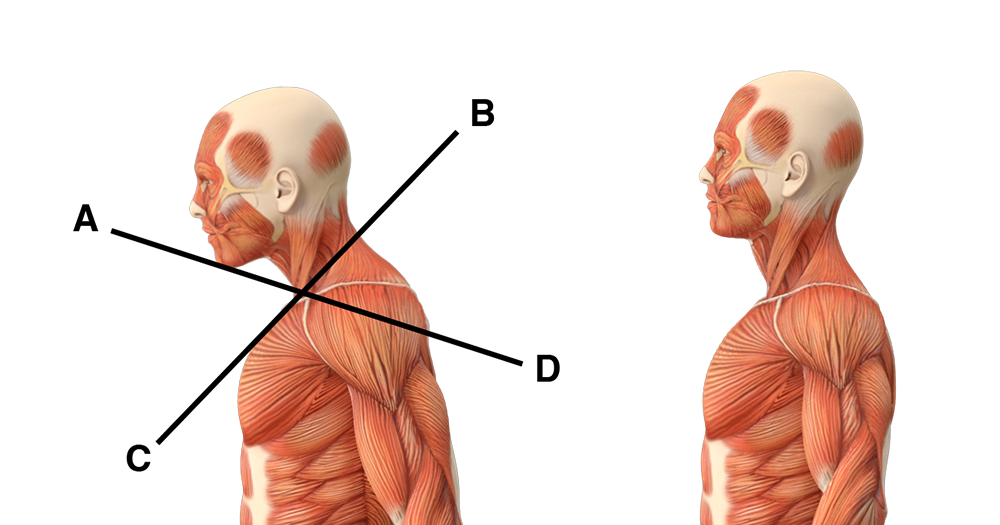Focus on superior crossed syndrome (MSD)
Technological advancements and the intensification of office work have radically transformed working conditions in the sector. Prolonged use of computers, tablets, or other digital devices, combined with static posture (sedentary lifestyle), favors the appearance of muscular and articular imbalances. Among musculoskeletal disorders (MSDs), the superior crossed syndrome, characterized by a posture with the head projected forward and an imbalance between hypertonic and hypotonic muscles, constitutes a major, underestimated risk in the professional environment.

Socio-economic impact and epidemiology
According to Evidence-Based Medicine (EBM), the prevalence of MSDs in the tertiary sector is constantly increasing. Employees who spend 8 hours a day or more in front of their screens are particularly exposed to the risks associated with prolonged poor posture. The superior crossed syndrome represents a significant proportion of these cases. The socio-economic impact is reflected in decreased productivity, increased absenteeism, medical care costs, and expenses for purchasing equipment to improve ergonomics. These consequences highlight the need for preventive and educational interventions in the workplace.
Physiopathology of the superior crossed syndrome
It is a series of events that follow its appearance.
- Initial posture: the prolonged use of computers and smartphones leads to a forward tilt of the head. The head represents 9% of the total body weight, a proportion that increases significantly in case of anterior projection.
- Muscle imbalance: this displacement causes an overload of the cervical and thoracic muscles. The anterior muscles (pectoralis, upper trapezius, levator scapulae) become hypertonic, while the posterior muscles (middle and lower trapezius, rhomboids, cervical flexors) weaken and lengthen.
- Cascade posturale : the unequal muscular effort causes a rotation and deformation of the vertebral column, with an increase in thoracic kyphosis and cervical lordosis. This anatomical configuration accentuates tensions and favors the appearance of chronic pain and articular dysfunction.

- A: the neck flexors become hypotonic (weak, stretched).
- B: the suboccipital muscles, the upper trapezius, the levator scapulae become hypertonic (short and tense)
- C: the pectoral muscles become hypertonic (short and tense).
- D: the middle trapezius, the lower trapezius, the rhomboids become hypotonic (weak, stretched).
The specific risk factors in the financial sector
- A static work posture: prolonged focus on one or more screens, combined with poorly adapted seated positions, leads to increased muscle fatigue.
- A non-ergonomic work environment: the lack of adjustments to work equipment (screen height, adjustable chair, lumbar support) exacerbates muscle strain.
- Teleworking: the widespread adoption of telecommuting, often carried out in less optimized home conditions, increases the risk of poor posture.
- The use of mobile devices: reading and typing on tablets or laptops often involves excessive tilting of the head and neck, contributing to muscle imbalance.

Clinical factors and diagnosis
The superior crossed syndrome manifests with varied symptoms that can appear gradually and worsen over time.
The typical clinical signs are:
- Cervical pain and headaches: muscle tension in the neck and upper back frequently causes cephalalgias.
- Numbness and paresthesia: nerve compression due to muscle tension can cause numbness sensations in the hands and arm.
- Muscle fatigue: a lack of endurance and a feeling of muscle weakness also characterize this syndrome.
The diagnosis is based on a comprehensive clinical evaluation, including a posture examination, an analysis of joint mobility, and if necessary, additional tests to rule out other patholog.
Consequences on health and professional performance
Chronic pain and discomfort often lead to:
- Decreased concentration: discomfort can reduce the ability to focus and maintain optimal performance.
- Increased absenteeism: musculoskeletal disorders (MSDs) are a major cause of absenteeism due to health reasons.
- Deterioration of quality of life: persistent pain and functional deficits can negatively impact both personal and professional life.
Some prevention strategies and ergonomic recommendations
Prevention of the superior crossed syndrome relies on a multidisciplinary approach combining ergonomic measures, physical strengthening exercises, and therapeutic education.
1. Ergonomic design of workstations
- Positioning and adjustment of the screen: The top of the screen should be positioned at eye level to avoid tilting the head.
- Choice of furniture: Using an adjustable chair with lumbar support and adjustable armrests allows for maintaining a neutral posture.
- Workstation settings: Adjusting the desk height, positioning the keyboard, mouse, and phone contribute to reducing postural constraints.
2. Behavioral and organizational interventions
- Regular break: Encourage micro-breaks to allow for muscle recovery.
- Employee awareness: Train and raise awareness among employees about good postural practices and the risks associated with prolonged use of their devices.
- Optimization of telework environments: Provide advice on how to set up a home workspace to promote a healthy and ergonomic work environment.
3. Therapeutic exercises and complementary interventions
- Exercise program (Ergo-coaching)
Regular sessions of muscle strengthening and stretching targeting hypertonic muscles (pectorals, upper trapezius) and strengthening hypotonic muscles (middle and lower trapezius, rhomboids) are recommended. - Chiropractic care
Chiropractic adjustments and manual therapy techniques can correct postural imbalances and improve joint mobility. - Medical follow-up and ergonomic eva
Early detection and personalized follow-up by healthcare professionals can help prevent the worsening of the syndrome.



Conclusion
The superior crossed syndrome represents a major risk of musculoskeletal disorders (MSDs), due to the time spent in front of screens and often poorly adapted working positions. It is essential to implement comprehensive prevention strategies. The ergonomic design of workstations, combined with therapeutic education and early medical care, can significantly reduce the prevalence of this syndrome and improve the quality of life of employees. The prevention of MSDs is not only a matter of comfort, but an essential lever for performance and well-being in the modern professional world.
The ASTF offers personalized approaches through training, recommendations, and personalized analyses. Discuss this with your occupational health physician.
Sources
“Upper crossed syndrome: Causes, symptoms, and exercises” https://www.medicalnewstoday.com/articles/318897
National Academy of Sport Medicine
“How to Fix Forward Head Posture” [Guide] https://blog.nasm.org/fixing-forward-head-posture
“Correcting Upper Crossed Syndrome” https://blog.nasm.org/correcting-upper-crossed-syndrome
PubMed Central
“The effect of middle and lower trapezius strength exercises and levator scapulae and upper trapezius stretching exercises in upper crossed syndrome” https://pmc.ncbi.nlm.nih.gov/articles/PMC4905927/
